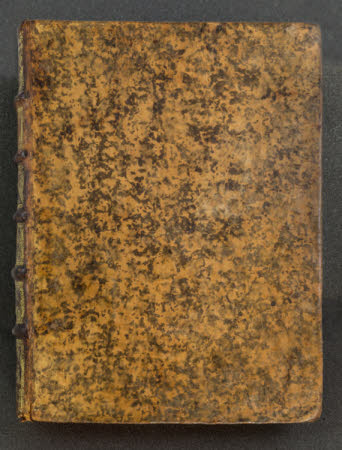Icones ipsis plantis ad uiuum expressae quoad fieri potuit noua quadem arte excogitata ab ipso auctore Fabio Columna pro ipsius oblectatione, studio, et memoria; ita ut facilè in perpetuo uiridario uiuere censeantur. Plantasuerò omnes è syluestribus locis, montibus, collibus, depressisq[ue] locis diuersarum prouinciarum in quibus auctor fuit proprijs manibus collegit, ut uix una, aut altera ex horto-pensili ab amico accepta reposuerit, tanta illius opera fuit et haec quidem nemine demonstrante qut docente [MS].
Fabio Colonna (1567-1650).
Category
Manuscripts and documents
Date
1600
Materials
Place of origin
Naples
Order this imageCollection
Blickling Hall, Norfolk
NT 3070960.2
Summary
A monumental manuscript in two volumes in the hand of Fabio Colonna (1567–1640), constituting a herbal produced using a process known today as nature printing.Lucia Tongiorgi Tomasi in 'An Oak Spring Herbaria' (Oak Spring Garden Library, 2009) writes of nature printing and of Colonna's manuscripts:'This complex technique involved sprinkling a plant, either freshly picked or dried, with organic pigments and then making a direct impression of it on a sheet of paper. Only a handful of examples of the use of this technique in the early sixteenth century are known, one being the herbal compiled by the Florentine pharmacist and perfumer Zenobio Pacini roday conserved in the Bibliothèque National, Paris.... In the herbal 'Icones ipsis plantis', which consists of no less than 570 sheets of nature prints, various illustrations include parts outlined in ink with the finer details sketched in; then watercolour added to recreate the colours of the flowers and the play of light and shadow on the leaves and petals.'
Full description
Fabio Colonna (1567–1640) was one of the most distinguished natural scientists of his time. Born in Naples, he went to the university there, graduating in law in 1589. Never strong, he nevertheless spent his days collecting plants, comparing and identifying them by reference to the classic Greek text of Dioscorides. He soon became known to all the major scientists of his time, notably his fellow Neapolitans, Ferrante Imperato and Giovani Battista della Porta. He was patronised by Prince Francesco Cesi, president of the Accademia dei Lincei, and corresponded with Galileo, Campanella and Charles de l’Ecluse. In addition to botany, he published works on zoology, physics, and geology. He was also a talented artist, engraving the 156 plates for his monograph on rare indigenous plants, printed in Rome in 1606. He published the first comprehensive account of the natural history of the New World, based on comparison of the new with familiar species. The problem of illustrating plants as they really were was one to which the botanists of the 16th century devoted a great deal of time and thought. Plants existed in four dimensions; over time, bud would be followed by flower, and flower by fruit, but in reality the three were seldom seen all together at once. In the Middle Ages, this was not a problem: the concept of reality lay less in depicting thins as the eye saw them than in a deeper vision, how God saw them. In the Renaissance, human vision, the problems of perspective, complicated as well as simplified depiction, and printing, illustrated first with woodcuts then engravings, developed its own conventions. Colonna was, perhaps, the first person to realise that specimens of the plants themselves might be used as the agents of a more truly realistic depiction. If carefully inked and pressed on to a sheet of paper, they left an impression, just like the wood-block of copper-plate, that could if so desired be coloured. This process, later known as ‘nature printing’, became very popular in the 19th century, but is unusual if not unique at the turn of the 16th century. This remarkable experiment was, perhaps, the result of his experience in engraving his own plates. There is nothing, however, to indicate that the volumes of ‘Icones’ were designed for publication; rather they were his own record of the plants that he collected. But Colonna also took a wider interest in the problems of depicting flowers, and his two books preserve not only his own ‘nature printing’, but also drawings and paintings of flowers by other hands, some contemporary, others earlier. Nicolas Barker, 1999
Bibliographic description
Vol. 2 . Running number: 5496. Provenance: Possibly acquired by Ellys when he was in Italy in 1697, whilst he was attending lectures at Padua University. Binding: eighteenth-century[?] mottled calf; sewn on five supports; gilt roll pattern on board edges; gilt spines, with fillets, roll and stamp tooling; gilt title on brown sheepskin label and vol. number on spines. Red stained edges. Comb-marbled endpapers.
Makers and roles
Fabio Colonna (1567-1650).
References
Barker, Nicolas. Treasures from the libraries of National Trust country houses. 1999., cat. 39, p. 90-1. Tongiorgi Tomasi and Willis 2009: Lucia Tongiorgi Tomasi & Tony Willis, 'An Oak Spring Herbaria: Herbs and Herbals from the fourteenth to the nineteenth centuries', Upperville Virginia, Oak Spring Garden Library: 2009., pp. 78.

